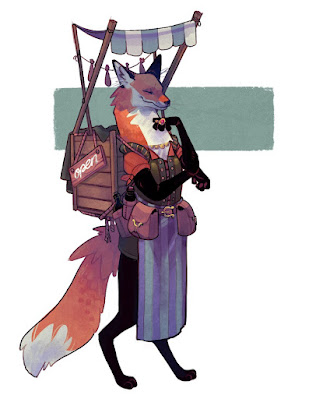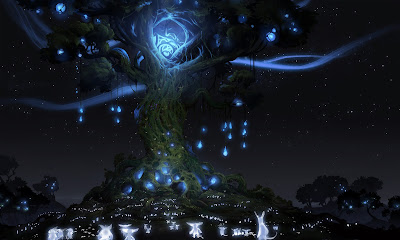[1] Elemental Spear
This spell conjures a magical spear made of elemental energy. To determine the element, pick the most fitting for the NPC or roll on the random table. (Roll 1d4) Fire, Ice, Lightning, Acid. The spear deals 1d8+1 damage on a hit and deals damage of its respective element. It counts as magic and uses the normal To-Hit bonus of the character wielding it.
As a spear, it grants either first strike, a bonus against targets larger then the caster, can poke things floating a few feet off the ground, etc. Because it is made of magical energy, it does not harm the caster that is holding it, but will burn the hands of anyone who tries to grab it, short out if brought into contact with water, etc. If you hit someone and deal 6 or more damage on a hit- the victim of the melee strike suffers the Overcharge
effect of its respective element.
If the spear is thrown- it is very similar to an Elemental Blast, except much more
powerful. The caster raises their hand and throws the spear- turning it into a projectile of elemental power along the way. The spear requires a d20 + Int modifier of the caster to hit (Magical To-Hit roll) and
deals 2d8 + Int modifier in damage. The spear explodes into a blast of elemental energy on contact.
In addition; whatever element the spear is also grants it an extra effect on hit when thrown.
Fire-
Creates a cloud of ash and smoke, choking anyone adjacent to the target
who tries to cast a spell. If the spear is blocked by the target has a
wooden shield, the shield burns up.
Ice- Stabs into the target as a physical object instead of exploding; piercing their body and pinning them down until it is broken, pulled out, or thawed. (Thaws naturally after 3 rounds).
Lightning-
Knocks victim to the ground, requiring a round to stand up.
Acid- Splashes acid around the hit- dealing
1d6 damage to everyone standing adjacent to the target. If you get hit by this and in a tight
hallway this could be your whole party.
[2] Swooper
Conjures a magical creature/weapon to strike at the caster's foes. The creature pantomimes the caster's motions and deals damage when striking a foe, dealing magical damage. The caster must control the creature and make attack rolls to guide it correctly. This creature tends to be a bird for casters of a Lawful alignment, or a screeching hellbat for casters of a Chaotic alignment; but individual magic users may have their own version.
The caster rolls a magical To-Hit roll (d20 + Int modifier) to attack with the bird. Enemies may attempt to knock it away with an attack roll of their own, but this requires a magic weapon and a higher To-Hit roll, which knocks the Swooper off course.
On hit, the swooper deals 1d6+1 damage. It can hit multiple targets; divide the damage according to cleave rules.
[3] Scissors of Splendor
Conjures forth golden scissors from an alternate dimension; specifically ones first found in the second of Four Golden Valleys. The scissors are very big, requiring two hands to operate, and beautifully engraved with ornate artwork and cross-thatching. The cutting edges are razor sharp and made of silver- anyone caught between the jaws of this tool take 1d10+2 magic damage unless they make a save to wriggle out- no attack roll needed, as these scissors cut through metal and defense alike.
The scissors are also known to be magical and can cut through binds of magic. Snipping the air above a magic circle or barrier "cuts" it, allowing entry into the circle without retaliation. Cutting the space just above the head of someone bewitched may cut the spiritual chord that binds them to their controller.
The magic scissors have another property- their apparent value. Anyone who sees them, wants them. Any living creature who desires gold and wealth (all of them) must make a save or try to pry the scissors away from the caster. Clerics and Holy men are immune to this effect. The scissors stay in this realm for four combat rounds before phasing away.
[4] Black Scythe of Harvest
Creates a shadowy black scythe of dark energy- tied closer to the power of the reapers and psychopomps. Enemies who make a morale check against the holder of this weapon make it as though they had one less morale.
If you sweep the scythe, all within a 30 ft cone of the user are "attacked" by his or her attack roll. Everyone who is struck takes 2d6+1 damage. Deals no damage against the undead.
If you raise the scythe, you can strike down one target- causing them to save or die on a successful attack roll. This is done instead of dealing damage.
You may make up to three attacks with the Scythe before it disappears. Caster ages 1d6 years.
[5] Lava Axe
Yes, just like the magic card. Makes a magical axe made of lava, acts as a 1d8+1 hand axe that deals fire damage. The axe does not harm the caster as long as they hold it- and retains its shape as an iron-hard axe until thrown, in which case it turns into lava and deals 1d10+1 fire damage when it hits a target.
The lava axe turns to stone if submerged or splashed with water- its loses its magic quality but retains its axe-like shape and could be used as a primitive stone axe of obsidian.
[6] Staff of Five Mountains
Creates a magical staff made from deep earth and iron ore- the staff rises out out of the ground wherever the spell was cast, cracking the earth and forming a magical staff. This spell cannot be cast if you're on a flying island or on a high floor of a building, it requires a close connection to the elemental earth.
The staff acts as a 1d4+1 magical iron warstaff. It grants +1 AC to the holder, but reduces your movement speed as though you are heavily encumbered. It also acts as a staff for magical spells, granting +1 damage to spells and making spells cast with it have harder saves by +1 for as long as its held. Additionally, anyone who is holding this staff may manipulate the earth freely for an action; carving out small trenches, creating small embankments or mounds of earth, etc. In practical terms, use the guidelines of Mold Earth per combat round as a rough estimate.
The staff gets heavier every turn it exists in this world- beginning as encumbering, then heavily encumbering, then requiring supernatural strength to hold (+3) or better, and so on. After one exploration turn; putting it down on the ground will cause it to begin to be reabsorbed by the ground and disappear back to its elemental plane.
[7] Fire Arrows
Magical box of arrows appears; each arrow is ended by a different shaped orb or cartridge of colorful wrapped paper. After two rounds, the magical fuses begin to light and go off. The arrows fly off and fly in random directions, but usually hit in a large cone out from the front of the weapon; this is an artillery piece. The weapon fires for three rounds, each round releasing 3d6 arrows.
Each time an arrow hits a target or the ground, it has one of three effects (1d3);
- Explodes in a colorful firework explosion (1d4+1 magic damage)
- Appears as an actual arrow (1d6)
- Has a random bomb effect (Roll on the Scuttsman Bomb Table)
[8] Sword of Likewise
While the spell is named the "Sword" of Likewise, its really closer to a dagger for most people- the size of the "sword" is directly tied to the Charisma score of the caster. The length of the sword is equal to your Charisma score in inches- use your Charisma modifier to substitute for Strength for To-Hit and Dex for the AC bonus.
The dark silver handle and guard emit a glowing blue magical blade. Any wounds struck or bodyparts severed by this sword are instantly cauterized or turned to dust, making regeneration without a high level divine spell impossible. If you cut off a part of your own body with this sword, it grows by the length of the bodypart you severed. The "length" of each caster's sword is remembered each time it is called back again, as each caster sword is actually a different entity entirely, called from whatever strange realm this thing hails from.
The sword lasts for one exploration turn until it must be called again.







